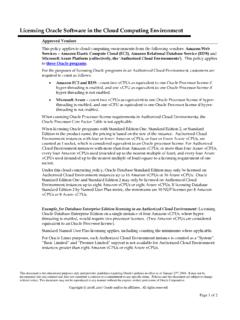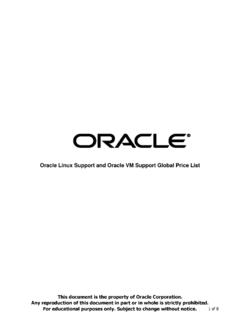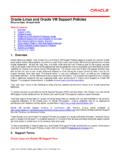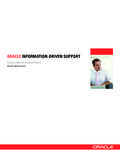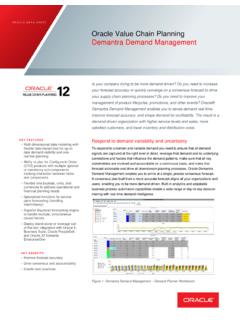Transcription of Implementing Information Lifecycle Management (ILM) …
1 Implementing Information Lifecycle Management (ILM) with oracle database 12c O R A C L E W H I T E P A P E R | M A Y 2 0 1 5 Implementing Information Lifecycle Management (ILM) WITH oracle database 12C Table of Contents Introduction 2 Information Lifecycle Management 3 Automating ILM with oracle database 12c 3 Implementing ILM with oracle database 12c 4 oracle database 12c ILM Implementation Example 5 Additional Features for Implementing ILM with oracle database 8 Conclusion 9 Implementing Information Lifecycle Management (ILM) WITH oracle database 12C Introduction Exponential increases in data volumes are putting enterprise IT infrastructures under severe pressure from a cost, performance, scalability and manageability perspective.
2 It has become imperative to employ more efficient ways of storing and managing data to meet the growing demands being placed on IT systems. Dramatic increases in storage volumes are evident in all types of applications, and enterprise applications are no exception. Although most organizations have long regarded their data as one of their most valuable corporate assets, only recently has the amount of data under Management become a major issue. Originally, data was used to help achieve operational goals to run the business, but as technology capabilities have grown, ever-larger databases have become feasible for both operational - OLTP - and analytical - Data Warehouse - applications.
3 Regulatory requirements are also changing how and why data is being retained, as many organizations are now required to retain and control much more Information for much longer periods. These requirements often extend beyond structured data - typically stored in relational databases such as oracle database to semi-structured and unstructured data such as medical images, videos, photos, contracts, documents, etc. The result is an explosion in the amount of data that organizations are required to obtain, organize, manage, and store securely (and safely), while still providing easy, scalable, and high-performance access.
4 Consequently, organizations are trying to store fast growing quantities of data for the lowest possible cost while meeting increasingly stringent regulatory requirements for data retention and protection. oracle database 12c contains a rich feature set that can help implement an Information Lifecycle Management (ILM) solution and meet these new data storage demands, including Data Partitioning, Advanced Row Compression, Hybrid Columnar Compression, Automatic Data Optimization, Heat Map, Direct NFS Client, Clonedb, SecureFiles, In- database Archiving, SecureFiles, and database File System (DBFS). Implementing Information Lifecycle Management (ILM) WITH oracle database 12C Information Lifecycle Management Information Lifecycle Management (ILM) is the practice of applying policies for the effective Management of Information throughout its useful life.
5 ILM for oracle database includes every phase of Information from its beginning to its end, and consists of the policies, processes, practices and tools used to align the business value of Information with the most appropriate and cost effective IT infrastructure -- from the time Information is created or acquired through its final disposition. Generally speaking, there are FIVE STEPS to implement an ILM strategy: 1. Define the Data Classes: For the primary databases that drive your business, identify the types of data in each database and where it is stored, and then determine: Which data is important, where it is, and what must be retained How this data flows within the organization What happens to this data over time and when is it no longer actively needed The degree of data availability, and protection, that is needed Data retention for legal and business requirements 2.
6 Create Logical Storage Tiers: For the data classes that represent the different types of storage tiers available in your environment. 3. Define a Lifecycle : A Lifecycle definition describes how data migrates across logical storage tiers during its lifetime. A Lifecycle definition comprises one or more Lifecycle stages that select a logical storage tier, data attributes such as compression and read-only, and a duration for data residing on that Lifecycle stage. To summarize, a Lifecycle defines WHERE to store data, HOW to store data and HOW LONG data should be retained. 4. Assign a Lifecycle to database Tables/Partitions 5.
7 Define and Enforce Compliance Policies Automating ILM with oracle database 12c When Implementing an ILM strategy with oracle database 11g, organizations typically use the Advanced Compression and Data Partitioning options to manually create and deploy a compression and storage tiering solution a solution which requires organizations to have sharp insight into data access and usage patterns across applications and tables/partitions. Based upon this insight, DBAs, along with their storage counterparts, can manually compress and/or move data based upon their best estimations regarding actual data usage, ideally trying to ensure that the most frequently accessed data remains on the highest performance storage.
8 What has become clear to many organizations, after Implementing manual storage tiering solutions, is that the ideal ILM solution is automated and is not reliant upon the organization s best guess of data access and usage patterns, but instead uses data usage Information maintained by the database . The ideal automation solution would provide policy-based classification of data based on usage, greatly simplifying the ILM implementation process. Heat Map and Automatic Data Optimization Two features were added to oracle database 12c to help automate ILM: Heat Map, and Automatic Data Optimization (ADO).
9 Both features are part of the oracle Advanced Compression option. Heat Map Implementing Information Lifecycle Management (ILM) WITH oracle database 12C Heat Map automatically tracks usage Information at the row and segment Data modification times are tracked at the row level and aggregated to the block level, and modification times, full table scan times, and index lookup times are tracked at the segment level. Heat Map enables a detailed view of how data is accessed, and how access patterns change over time. Programmatic access to Heat Map data is available through a set of PL/SQL table functions, as well as through data dictionary views.
10 In addition, oracle Enterprise Manager provides graphical representations of Heat Map data. Automatic Data Optimization Automatic Data Optimization (ADO) allows organizations to create policies for data compression and data movement, and to implement automatic tiering of compression and storage. oracle database evaluates ADO policies during the DBA-defined database maintenance window, and uses the Information collected by Heat Map to determine which operations to execute. All ADO operations are executed automatically and in the background, with no user intervention required. ADO policies can be specified at the segment or row level for tables and table partitions.
